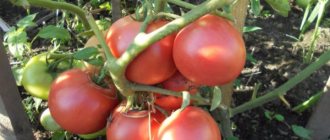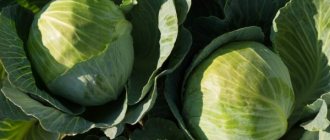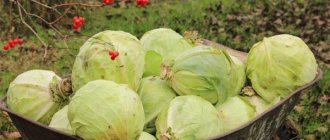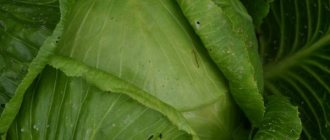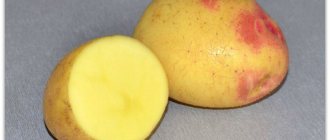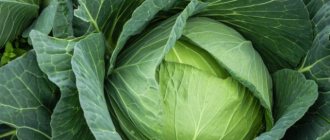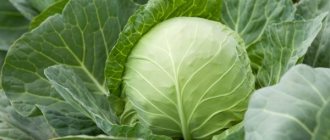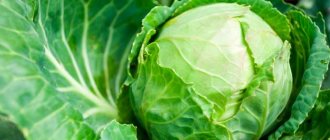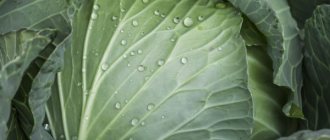Vegetable growing » Cabbage
0
1271
Article rating
Kira Stoletova
Growing Broccoli Tonus cabbage is a simple process. The variety produces the first harvest within 2 months after planting, grows well in frosts, is undemanding in care and contains many useful vitamins.
Description of broccoli cabbage Tonus
Broccoli Tonus: description and characteristics of the variety
Broccoli is native to Italy. After passing through Germany, it reached Russia. At the moment, it has not yet received proper distribution.
Broccoli "Tonus" was obtained by Russian breeders.
In 1986, it received permission for use throughout the country.
Photo of a bag of seeds:
The main thing here is not the leaves, as, for example, in ordinary white cabbage, but the inflorescences of a rich dark green hue. The length of the plant's branches can reach almost a meter in length.
Tonus refers to mid-season broccoli varieties: the fruits ripen two to three months after planting. It is profitable to grow Tonus cabbage: it is capable of producing crops until frost. It turns out that in one season you can harvest up to three times.
Dimensions, shape of leaves:
Representatives of this variety have medium-sized leaves. The dark green leaf has a waxy coating that adds a bluish tint to the leaf. The plate itself has an ovoid-truncated shape. The length ranges from 9 to 14 cm, the width varies from 7 to 10 cm. The leaf has a slightly wrinkled surface. There is slight wavy along the edges.
The head grows up to 8 cm. It has medium density and a dark green color, like the leaves. The weight of one head reaches 200 grams. After trimming one, new heads appear in a short period of time.
The taste of the broccoli variety Tonus is excellent.
Advantages and disadvantages
Broccoli Tonus is not inferior in number of advantages to the latest varieties and hybrids:
- Cabbage contains many useful substances and vitamins.
- The vegetable can be consumed raw, after freezing, canning and hot heat treatment. Read how to prepare vegetables here.
- The variety continues to form inflorescences when the air temperature drops sharply.
- Cabbage yields are significantly increased due to the fact that after cutting the main part, axillary heads are formed en masse.
- The plant is capable of forming repeated inflorescences until frost.
- The density of the heads is sufficient for painless transportation of the crop.
Flaws:
- cabbage cannot be stored fresh for a long time;
- with a prolonged decrease in temperature, the heads develop a brownish tint;
- insufficient watering and intense solar radiation lead to rapid flowering of buds.
Broccoli tone: advantages and disadvantages
Broccoli, including the “Tonus” variety, has advantages and disadvantages.
Among the advantages and benefits of Tonus cabbage it is worth noting:
- High content of ascorbic acid, vitamin B9 (folate) and provitamin A (beta-carotene);
- A large amount of proteins and minerals: calcium, potassium, iron and others;
- The presence of such organic compounds as glucosinolates. They are known for their antitumor properties;
- Low energy value, which makes cabbage indispensable for dietary nutrition;
- The composition is enriched with dietary fiber.
Disadvantages of the variety: during the cooking process, with excessive heat treatment, sulfur compounds are released, accompanied by an unpleasant odor. There is a risk of bloating.
Broccoli: growing and care
The broccoli variety “Tonus” is one of the varieties that does not require a lot of effort to grow.
Broccoli: agricultural cultivation techniques
For an early (first) harvest, you need to sow broccoli tonus seeds for seedlings when the very beginning of spring arrives (depending on the climatic conditions of a particular region). In the case of a late harvest, when you plan to eat the fruits in winter, the ideal time is from May to June.
Important! The main condition when planting seeds: the end of frost.
Soil preparation
Before planting seeds in the ground, it is important to properly prepare the soil. It is prepared as follows:
- A piece of land with a slightly alkaline or neutral environment is allocated. This could be an area where potatoes, carrots, and legumes previously grew;
- Compost is added and fertilized with mineral fertilizer during the digging process. 5 kg of fertilizer is applied per 1 m2;
- Lime and nitrogen (acidic) are added to the soil.
THIS IS INTERESTING!
•
When and how to plant cabbage seedlings for a good harvest When growing broccoli in open ground, choose a place with good sunlight.
Video: when to sow cabbage for seedlings in Siberia
Planting seedlings
When growing broccoli tonus seedlings, you should follow the following rules:
- Before planting in open ground, you need to wait until the first shoots with three to four leaves appear;
- It is necessary to maintain a distance between plants: 45 - 50 cm between bushes;
- Maintain a distance of 35 - 40 cm between rows;
- At the time of planting seedlings, fertilizing in the amount of 5 - 7 grams of inorganic fertilizers is applied to each hole;
- After planting the seedlings, sprinkle a little soil on top;
At the final stage of planting, the plants should be watered.
Important! Maintaining distances is necessary for the proper formation and growth of plants.
Among the mandatory components of caring for the “Tonus” broccoli variety are: watering, fertilizing, loosening the soil. It is important to control the temperature: it should be between 15 and 25 degrees.
Photo:
At first after planting, you need to water the plant once a week. When the air temperature reaches 25°C and above, you need to moisten the soil more often: once every two to three days. Broccoli should be watered at the root, and the foliage should be sprayed. The best time is evening.
Broccoli - feeding
Fertilizing and feeding broccoli occurs according to strict rules:
- The very first fertilization with mullein solution is carried out 14 days after planting the seedlings in open ground;
- The second time the treatment is carried out with a solution of nitrate;
- In August it is worth applying mineral fertilizers containing potassium and phosphorus;
- After harvesting, fertilizer is applied to the side branches. The fertilizer is prepared from nitrate, potassium, water and phosphate. Before the onset of winter, it is worth adding ash under each mouth in the amount of 1 tablespoon per 1 m2.
Good variety!
• early-ripening June cabbage • mid-ripening hybrid Krautman F1 • late-ripening varieties: Aggressor F1, Sugarloaf, Atria F1
Broccoli: pests and diseases
Like many vegetable crops, broccoli is susceptible to pests and diseases. The most common are aphids, flies, fleas, whitefish
. To combat them, it is necessary to treat the plants with a soap solution, infusion of celandine, tansy. Of the synthetic drugs, Ambusha and Foxim are recommended. For slugs and snails, use tobacco or ground pepper, sprinkled between the rows.
Broccoli Tonus is susceptible to diseases such as: whiteness, powdery mildew, black leg, mosaic.
To prevent the development of the disease, a solution of potassium permanganate and copper sulfate is used.
For powdery mildew, cabbage foliage is treated with ordinary ash.
Adding nitrogen to the soil to acidify it will prevent white rot.
For mosaic, only chemicals are effective.
Characteristics of broccoli fruits and yield
The Tonus variety has large fruits: they can weigh up to 200 grams. The leaves are dark green. The harvest ripens together, in one moment.
The variety is productive.
Per square meter of area there are 1.6 - 1 kg. The best time to pick ripe broccoli fruits is early in the morning.
The fruits collected in the first harvest should be immediately consumed. Autumn fruits can be stored for a longer time.
Broccoli - benefits and applications
Broccoli is very healthy, as proven by scientific research. It contains many useful substances that significantly reduce the possibility of neoplasms. In addition, broccoli contains a small amount of calories, which makes it a dietary food product.
Broccoli of the “Tonus” variety can be eaten raw and fresh. Frozen is no less useful. You can also steam broccoli or cook in a double boiler. Broccoli of the Tonus variety is suitable for canning and preparing snacks for the winter.
Reviews
Broccoli Tonus has collected many different reviews. They say the following about her:
- After cutting off the central part, the cabbage produced many additional small “fruits” until late autumn - Natalya from Moscow.
- The heads are smaller than the stated size, but the vegetable is very tasty - Marina from Chelyabinsk.
- The variety has too high a stem and begins to flower quickly - Maria from St. Petersburg.
- Cabbage is unpretentious, but it needs good watering - Antonina from Ufa.
Broccoli Tonus is beneficial because it continues to grow new heads after cutting off the central one. With improper care and untimely harvesting, cabbage can disappoint with abundant flowering.
Broccoli Tonus - review
I like the “Tonus” variety of broccoli: it does not require special care and produces fruit two or three times a season. I plant seedlings in June to get a double harvest. The latest - the second harvest in this case occurs in late autumn - the onset of the first frost. So in winter I always have fresh cabbage on my table.
Broccoli of the "Tonus" variety tastes good. Good in any form, including canned. Frozen fruits are stored for a long time and do not lose their benefits.
I recommend this variety for cultivation.
Any gardener can leave reviews about Tonus broccoli on the website, and also add photos of the grown crop to the reviews if desired.
Description from the manufacturer Aelita
Early ripening variety. The central inflorescence weighing up to 200g ripens 35-40 days after planting the seedlings. After cutting, up to 7 lateral inflorescences develop, which ensures long-term fruiting. It deserves the widest distribution due to its exceptional benefits for human health.
To obtain early production, sow seedlings in mid-March. Picking in the cotyledon phase. Planting seedlings in the ground at the end of April - beginning of May, at the age of 35-45 days with 4-5 true leaves according to a 60x30 cm pattern. To extend the season for consuming broccoli, you can sow seeds for seedlings at intervals of 2 weeks 3-4 times per season and use varieties of different ripening periods. It is possible to sow seeds in open ground from May to early July, to a depth of 0.5-1 cm.
For good growth and abundant fruiting, plants need timely watering, regular weeding, loosening and fertilizing with mineral fertilizers.
This variety is also produced by many other manufacturers: Plasma Seeds, Gavrish, Lucky Seeds, Altai Seeds and others.
Landing
Seeds can be planted directly into the beds in May or seedlings can be grown. Seedlings are sown in April or a month before transferring to the site.
Before sowing, the seeds are hardened in hot and cold water (soaked for half an hour in a hot temperature of +50, then 2-3 minutes in cold). Then they are etched in a solution of potassium permanganate 1% or the drug “Prestige”. The grains are rinsed, dried and placed in grooves 0.5-1 cm deep at a distance of 3-5 cm from each other.
The soil should contain peat, sand, turf soil and wood ash. The substrate is calcined in an oven or poured with boiling water and potassium permanganate, then allowed to stand for 2-3 days to form beneficial microflora.
Keep at room temperature until germination. When the shoots appear, set the temperature to +12-14 degrees for five days, and after that keep it at +14-18 degrees.
The site is prepared in autumn or early spring. The optimal place is sunny, the best predecessors are carrots, potatoes, tomatoes, cucumbers, zucchini, legumes. Dig up the bed, add 5 kg of compost per 1 square meter. m and some mineral fertilizers. Seedlings are planted according to a 45 by 35 cm pattern.

